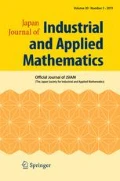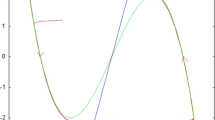Abstract
A simplified coupled reaction-diffusion system is derived from a diffusive membrane coupling of two reaction-diffusion systems of activator-inhibitor type. It is shown that the dynamics of the original decoupled systems persists for weak coupling, while new coupledstationary patterns ofalternated type emerge at a critical strength of coupling and become stable for strong coupling independently of the dynamics of the decoupled systems. The approach which we use here is singular perturbation techniques and complementarily numerical methods.
Similar content being viewed by others
References
H. Fujii, M. Mimura, and Y. Nishiura, A picture of the global bifurcation diagram in ecologically interacting and diffusing systems. Physica D,5 (1982), 1–42.
A. Gierer and H. Meinhardt, A theory of biological pattern formation. Kybernetik,12 (1972), 30–39.
P. De Kepper, V. Castets, E. Dulos, and J. Boissonade, Turing-type chemical patterns in the chlorite-iodide-malonic acid reaction. Physica D,49 (1991), 161–169.
I. Lengyel and I. R. Epstein, Modeling of Turing structures in the chlorite-iodide-malonic acid-starch reaction system. Science,251 (1991), 650–652.
M. Mimura, M. Tabata, and Y. Hosono, Multiple solutions of two-point boundary value problems of Neumann type with a small parameter. SIAM J. Math Anal.,11 (1981), 613–631.
J. D. Murray, A pre-pattern formation mechanism for animal coat marking. J. Thoret. Biol.,88 (1981), 161–199.
J. D. Murray, Mathematical Biology. Springer-Verlag, 1989.
Y. Nishiura, Coexistence of infinitely many stable solutions to reaction diffusion systems in the singular limit. Dynamics Reported (New series),3, Springer Verlag, 1994.
Y. Nishiura and H. Fujii, Stability of singular perturbed solutions to systems of reactiondiffusion equations. SIAM J. Math. Anal.,18 (1987), 1726–1770.
Y. Nishiura and M. Mimura, Layer oscillations in reaction-diffusion systems. SIAM J. Appl. Math.,49 (1989), 481–514.
T. Ohta and H. Nakazawa, Self-organization in an excitable reaction-diffusion system. II. Reduction to a coupled oscillator. Phys. Rev., A,45 (1992), 5504–5511.
A. M. Turing, The chemical basis of morphogenesis. Philos. Trans. Roy. Soc. London, B237 (1952), 37–72.
A. T. Winfree, The Geometry of Biological Time. Biomath., vol. 8, Springer-Verlag, 1980.
D. Winston, M. Arora, J. Maselko, V. Gáspár, and K. Showalter, Cross-membrane coupling of chemical spatiotemporal patterns. Nature,351 (1991), 132–135.
Author information
Authors and Affiliations
About this article
Cite this article
Takaishi, T., Mimura, M. & Nishiura, Y. Pattern formation in coupled reaction-diffusion systems. Japan J. Indust. Appl. Math. 12, 385–424 (1995). https://doi.org/10.1007/BF03167236
Received:
Issue Date:
DOI: https://doi.org/10.1007/BF03167236




